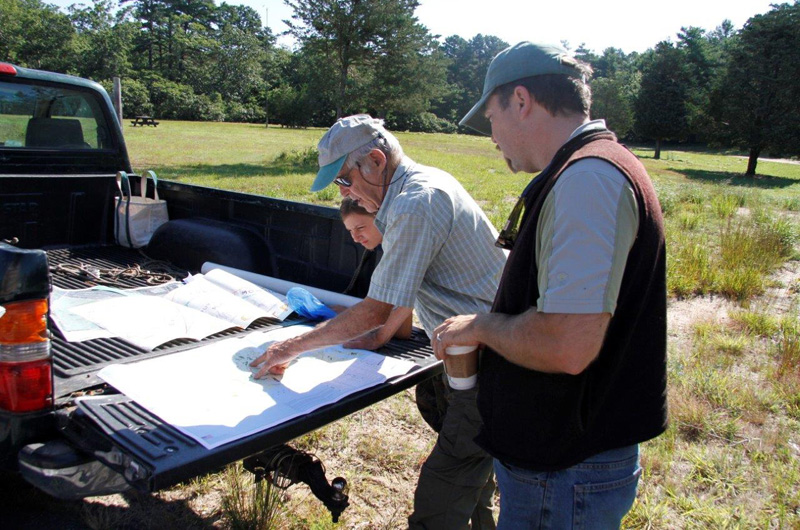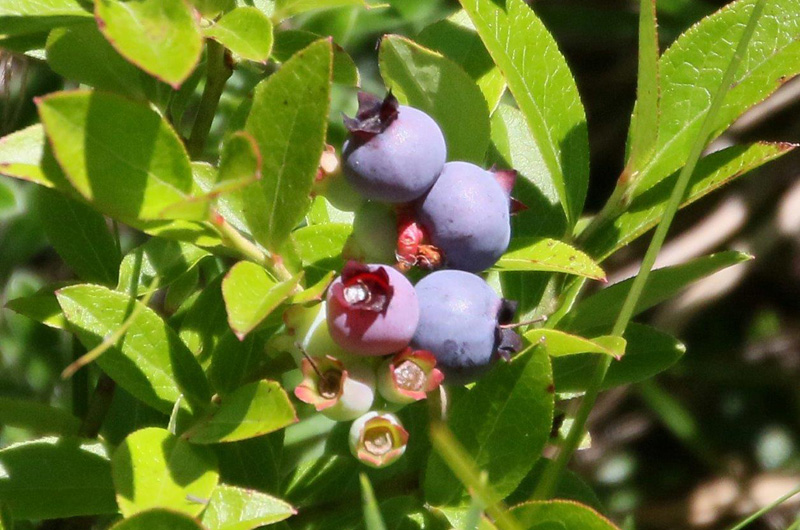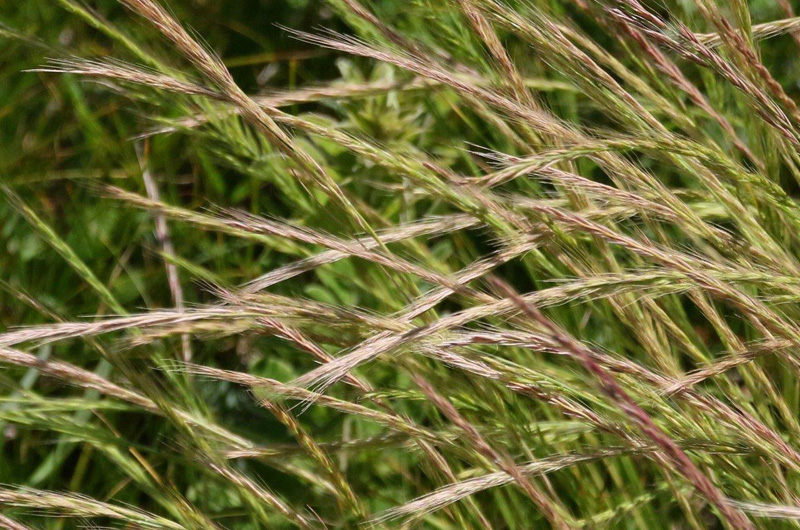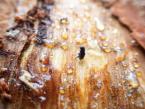Thousands of years ago, a torrent of glacial meltwater swept outward across what is now Martha’s Vineyard, toward the ocean 50 miles to the south. It carved out a series of channels and coves that remain today as depressions north of the great ponds: Deep Bottom, Willow Tree Bottom, Waldren Bottom and others.
On a blazing afternoon last week, Bob Woodruff, an amateur geologist and former director of the Vineyard Conservation Society, looked out across a corridor of low vegetation in the Manuel F. Correllus State Forest. “We are in the upper reaches of one of those channels,” he said, noting a subtle dip in the landscape.

The corridor extended about 20 feet on either side of a fire trail that ran for about 3.5 miles from one end of the forest to the other. A network of similar trails and clearings covers about 60 miles throughout the forest.
Scrub oaks where the clearing met the forest are stunted by countless frosts over the years, and were denuded below about three feet as the result of a frost this spring. Temperatures in frost bottoms around the Island might drop below freezing in almost any month of the year.
Regular mowing has helped maintain not only the fire trails but a diverse mix of plants that grow in the clearings. And controlled burns elsewhere in the forest have helped create similar habitat. With more plant species come more animals, Mr. Woodruff said, noting the benefits of both techniques in maintaining a healthy ecosystem.
Mr. Woodruff and forest superintendent Chris Bruno, along with Tim Simmons, a former restoration ecologist with the state Natural Heritage and Endangered Species Program, will lead a tour of the state forest on Thursday, focusing on controlled burns as a management strategy. The tour leaves at 9 a.m. from the forest headquarters off Barnes Road and wraps up at 11 a.m.
Farther back from the trails, shrubs and grasses give way to oaks and pitch pines, parts of a highly intact sandplain landscape that covers 5,350 acres in Edgartown and West Tisbury.
A forest management plan developed several years ago in conjunction with the state Department of Conservation and Recreation, which manages the forest and the natural heritage program, aims partly to preserve the many rare and endangered plant species that inhabit the fire trails and other clearings.
The fire trails themselves are mowed, not burned, but the effect is similar. Ninety per cent of the rare species that inhabit the forest are found there, Mr. Woodruff said, noting that more light creates better habitat.
As part of the management efforts, Mr. Woodruff has been surveying the forest every week this summer with photographer and naturalist Lanny McDowell and others in an effort to catalogue the rare and endangered plant species.
Farther west, Mr. Woodruff pointed out an assortment of sandplain species surrounding the trail, including sweet fern, arctic bearberry, baptisia and a stand of huckleberries. This has been a good year for wild blueberries, Mr. Bruno said, perhaps as a result of increased rainfall earlier in the year.
He pointed to some seed pods on the baptisia, a shrubby perennial with yellow or blue flowers. “If I came through and mowed this right now, that wouldn’t have a chance,” he said, explaining that mowing needs to happen in concert with the timing and assortment of plants in the trails. He said managing the trails originally served to provide access for crews and equipment, but is now seen also as promoting habitat.
In another location in the forest, erosion has exposed an ancient gravel stream bed leading down into a deep frost bottom, buried in a layer of sand washed down from the hillside. Clumps of native bluestem, with hints of amber and gold, had found their purchase in the middle of a fire trail, surrounded by aster, blueberries and other species.
Mr. Bruno kicked up some sand in the fire trail. “The whole forest is growing in this kind of soil,” he said somewhat incredulously. “It’s a beach.”
“I call it a desert,” Mr. Woodruff said.
Some might also call it a prairie, at least in spirit. Little and big bluestem, which are found along the south shore and in pockets around the Island, helped sustain the vast buffalo herds in the central part of the continent, which in turn sustained many Native American tribes. (To support the buffalo, the tribes often helped maintain the ecosystem with fire.)
Prescribed fire in the state forest has occurred on a regular basis since the late 1990s, including almost annually in the last few years. A controlled burn last October was the largest in state history, clearing 200 acres in the northeast section of the forest.
“Right now it looks absolutely gorgeous,” Mr. Bruno said of the area. “You can see into the woods hundreds of yards now, because it’s taken out all of this thick stuff and it’s just this low green carpet. It’s really beautiful.”
At the same time, wildfire can destroy much more than it creates. The most notable casualty on the Island, at least indirectly, was the heath hen, or eastern prairie chicken, whose plight in the early 1900s led to the creation of a large preserve that later became the state forest.
In 1839, the heath hen was declared extinct everywhere except Martha’s Vineyard. Following the creation of the heath hen preserve in 1908, the population rebounded, with some 2,000 birds accounted for in 1916. But a cataclysmic fire during nesting season that year burned as many as 13,000 acres on the Island, destroying many heath hens and all of their eggs.
“It was, in fact, fire which made extinction for the heath hen finally certain,” Gazette publisher and editor Henry Beetle Hough wrote in an obituary for the species in 1933. At the time, he blamed the characteristically late springs on the plains, and the abundance of scrub oak, for the conflagration.
But Mr. Bruno pointed out that it was also a lack of fire in previous years that allowed for the buildup of scrub oak and underbrush that fueled the blaze.
More fuel in the form of woody plants means taller flames that are harder to control, he said. In that sense, controlled burns have a dual purpose. “When you manage for fire safety, you are also managing for habitat,” he said. But he added that it’s a fine line between enough fire and too much.
Looking ahead, Mr. Bruno wants to improve public education, possibly by adding informational kiosks in the forest or creating handouts for visitors. Among other things, the tour on Wednesday will test public interest in forest ecology. Mr. Woodruff said if there is enough demand, foresters could develop a series of handouts related to geology, botany and other topics, which visitors can borrow and return.
Along a bike path, and within earshot of the Edgartown-West Tisbury Road, stands a large bronze statue of a heath hen, the last of which, Booming Ben, passed away on a neighboring property. The mowed landscape around the statue hosts a suite of sandplain species, including reindeer moss, dwarf prairie willow and varieties of scrub oak — a microcosm of the original heath hen habitat.
Mr. Bruno looked out across a large frost bottom to the south. “This would be a good place to reduce fuels and open up the view,” he said. He said he also hopes to add some information about the statue, which was part of The Lost Bird Project, which aimed to raise awareness about extinct birds and their habitats. Four other bird statues have been installed between Florida and Newfoundland.
The small team of foresters stepped aside now and then to let people whiz by on the bike path, then returned to browsing the low vegetation, pointing out rare and uncommon species, or just ones that piqued their interest. Mr. Woodruff said the tour on Wednesday would likely end up here — a fitting tribute to the forest and the many fire-adapted species that have called it home.
Before heading back to a van perched at the top of the frost bottom, he offered a brief solute to the unsung statue. “Thank you, Ben,” he said. “We wouldn’t be standing here without you.”









Comments
Comment policy »